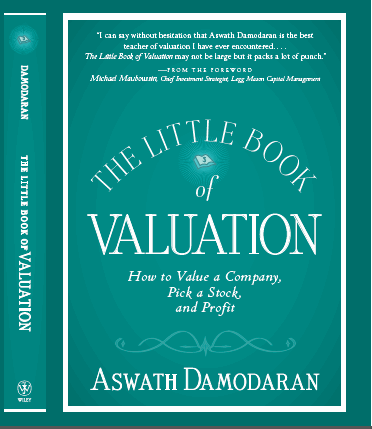 The
Little Book of Valuation
The
Little Book of Valuation The
Little Book of Valuation
The
Little Book of Valuation
We
have covered the four inputs that go into discounted cash flow valuation models
– cash flows, discount rates, growth rates and the terminal value. The
present value we arrive at, when we discount the cash flows at the
risk-adjusted rates should yield an estimate of value, but getting from that
number to what we would be willing to pay per share for equity does require use
to consider a few other factors.
a.
Cash and Marketable Securities: Most
companies have cash balances that are not insignificant in magnitude. Is this
cash balance already incorporated into the present value? The answer depends
upon how we estimated cash flows. If the cash flows are based on operating
income (free cash flow to the firm) or non-cash net income, we have not valued
cash yet and it should be added on to the present value. If, on the other hand,
we estimate cash flows from the cumulative net income or use the dividend
discount model, cash already has been implicitly valued; the income from cash
is part of the final cash flow and the discount rate presumably has been
adjusted to reflect the presence of cash
b.
Cross Holdings in other companies:
Companies sometimes invest in other firms, and these cross holdings can
generally be categorized as either minority or majority holdings. With the
former, the holdings are usually less than 50%, and the income
from the holdings are reported in the income statement below the
operating income line. If we use free cash flow to the firm to value the
operating assets, we have not valued these minority holdings yet, and they have
to be valued explicitly and added to present value. With majority holdings,
which generally exceed 50%, firms usually consolidate the entire subsidiary in
their financials, and report 100% of the operating income and assets of the
subsidiary. To reflect the portion of the subsidiary that does not belong to
them, they report the book value of that portion as minority interest in a balance
sheet. If we compute cash flows from consolidated financial statements, we have
to subtract out the estimated market value of the minority interest.
c.
Potential liabilities (not treated as debt):
Since we are interested in the value of equity in the firm, we have to consider
any potential liabilities that we may face that reduce that value. Thus, items
like under funded pension obligations and health care obligations may not meet
the threshold to be categorized as debt for cost of capital purposes but should
be considered when valuing equity. In other words, we would subtract out the
values of these and other claims (such as potential costs from lawsuits against
the firm) on equity from firm value to arrive at equity value.
d.
Employee Options: Having arrived at the
value of equity in the firm, there is one final estimate that we have to make,
especially if the firm has made it a practice to grant options to managers.
Since many of these options will be still outstanding, we have to consider them
as another (and different) claim on equity. While analysts often use short cuts
(such as adjusting the number of shares for dilution) to deal with these
options, the right approach is to value the options (using an option pricing
model), reduce the value of equity by the option value and then divide by the
actual number of shares outstanding.
Table
2.9 summarizes the loose ends and how to deal with them in the different
models.
Table 2.9: Dealing with loose ends in
valuation
|
Loose End |
Dividend Discount Model |
FCFE Model |
FCFF Model |
|
Cash and Marketable
Securities |
Ignore, since net income
includes interest income from cash. |
Ignore, if FCFE is computed
using total net income. Add, if FCFE is computed using non-cash net income |
Add. Operating income does
not include income from cash. |
|
Cross Holdings |
Ignore, since net income
includes income from cross holdings. |
Ignore, since net income
includes income from cross holdings. |
Add market value of
minority holdings and subtract market value of minority interests. |
|
Other Liabilities |
Ignore. The assumption is
that the firm is considering costs when setting dividends. |
Subtract out expected
litigation costs. |
Subtract out under funded
pension obligations, health care obligations and expected litigation costs. |
|
Employee options |
Ignore. |
Subtract out value of
equity options outstanding |
Subtract out value of
equity options outstanding |